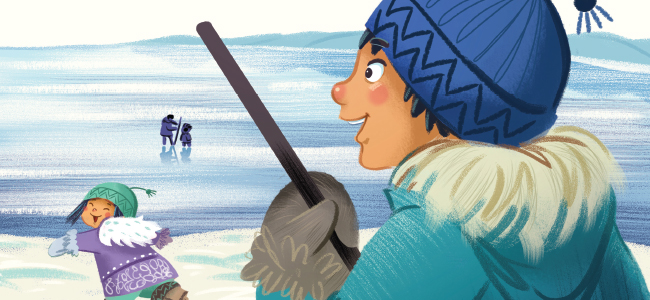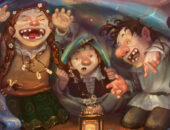
Fishing With Grandma
ᐊᓕᐊᓇᐃᑦᑐᖅ ᐱᒋᐊᓕᓚᐅᖅᐳᖅ ᐊᓈᓇᑦᑎᐊᖓᑕ ᐃᕐᖑᑕᖏᒃ ᒪᕐᕉᒃ ᐊᐅᓪᓚᖃᑎᒋᖕᒪᒋᒃ ᑕᓯᕐᒧᑦ. ᖃᐅᔨᑎᐊᓪᓚᓚᐅᖅᑐᓂᒋᒃ ᖃᓄᒃ ᐸᕐᓇᒃᐸᖕᒪᖕᒑᑕ ᐃᖃᓗᒐᓱᒋᐊᕐᓗᑎᒃ, ᐊᓈᓇᑦᑎᐊᖓ ᐃᕐᖑᑕᖏᓪᓗ ᐊᐅᓚᓴᓕᖅᑐᑎᒃ ᖁᕕᐊᓱᒃᑐᑎᒃ ᑕᓯᕐᒥᑦ. ᐊᓈᓇᑦᑎᐊᖓᑕ ᖃᐅᔨᑎᑦᑐᓂᒋᒃ ᖃᐅᔨᒪᔭᕆᐊᖃᕐᑕᖏᓐᓂᒃ ᐃᖃᓪᓕᐊᕐᓗᑎᒃ ᐊᑐᑦᑎᐊᕆᐊᖃᖅᑕᖏᓐᓂᒃ, ᐊᓐᓄᕌᓂᒃ ᐊᑐᕆᐊᖃᖅᑕᖏᓐᓂᒃ, ᖃᓄᖅ ᐊᖕᒪᖅᓯᔭᕆᐊᖃᕐᓂᕐᒥᑦ ᐊᓪᓗᐊᒥᑦ ᑕᓯᕐᒥᑦ, ᖃᓄᕐᓗ ᐋᖅᑭᒃᓯᓂᕐᒥᑦ ᐃᓄᐃᑦ ᐊᐅᓚᓴᐅᑎᓕᐊᖏᓐᓂᒃ. ᐅᓪᓘᑉ ᐃᓗᐊᓂ, ᓄᑕᖅᑲᑦ ᒪᒪᑕᓕᐅᖅᑐᑎᒃ ᐃᖃᓗᖕᒥᑦ, ᐊᒻᒪᑦᑕᐅᖅ ᐃᓕᑦᑎᓪᓗᑎᒃ ᖃᐅᔨᒪᔭᕆᐊᖃᖅᑕᖏᓐᓂᑦ ᐃᓄᑑᓗᑎᒃ ᑕᓯᓕᐊᕐᓂᖅᐸᑕ.
Adventure begins when Grandma takes her two grandchildren out for a trip to the lake. After showing the kids how to prepare for a fishing trip, Grandma and the kids enjoy a day of jigging in the ice for fish. Grandma shows them everything they need to know to complete a successful fishing trip, from what clothes to wear, to how to drill and clear holes in the ice, to how to make a traditional Inuit jigging rod. By the end of the day, the kids have a yummy meal of Arctic char, and they have also learned everything they need to know to go out on the lake on their own.
Written by Susan Avingaq and Maren Vsetula | Illustrated by Charlene Chua
Paperback (English) | ISBN: 978-1-77227-084-6 | $14.95 |8.5″ x 8.5″ | 32 pages | | Full-colour illustrations throughout
Paperback (Inuktitut) | ISBN: 978-1-77227-072-3 | $10.95 |8.5″ x 8.5″ | 32 pages | | Full-colour illustrations throughout
Praise
“. . . Fishing with Grandma, which offers an engaging tale of two grandchildren and their grandma on an Arctic adventure, is ideal for primary grades.” — CM Magazine
“Readers learn about the traditional tools of the trade through prose peppered with Inuktitut and also take away a sweet message of caring for our elders, as the youngsters share their yummy Arctic char with those who can no longer jig for themselves.” — Hakai Magazine
“Brightly colored full-page scenes exemplify the children’s fascination and clearly illustrate the tools they use on their adventure. A natural fit for a social studies classroom, but also a cheery tale of intergenerational family life.”—Booklist
“This well written and clearly illustrated book can be used by primary school teachers to address several areas of the curriculum such as seasonal changes, adaptations needed to survive changes in weather and temperature, food sustainability, and Indigenous fishing practices. During the reading of the book, students can be encouraged to practise their thinking skills by making predictions, asking questions and connecting aspects of the story to their own lives.”—Canadian Teacher Magazine
Awards
Best Books for Kids and Teens – The Canadian Children’s Book Centre, 2017





